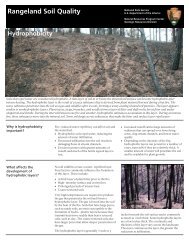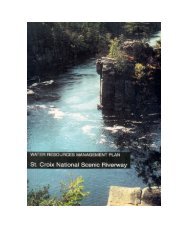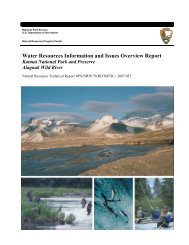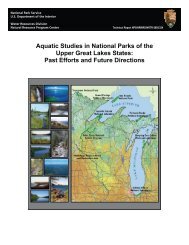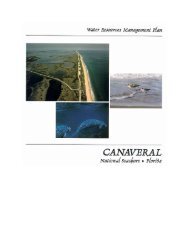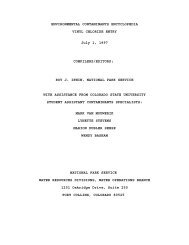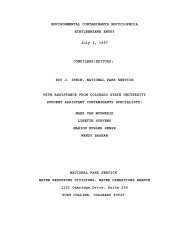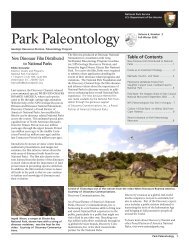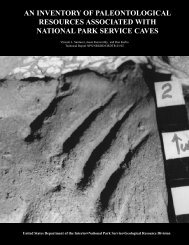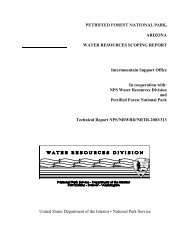Buck Island Reef National Monument Geologic Resources Inventory
Buck Island Reef National Monument Geologic Resources Inventory
Buck Island Reef National Monument Geologic Resources Inventory
You also want an ePaper? Increase the reach of your titles
YUMPU automatically turns print PDFs into web optimized ePapers that Google loves.
communications, September 20, 2011). The new plan<br />
emphasizes protection and safety in order to avoid<br />
impacts to threatened coral species, avert vessel<br />
groundings on shallow reef areas, and reduce hazardous<br />
navigating conditions for boaters.<br />
Seagrass Beds<br />
Seagrass beds in the Caribbean are generally a mixture of<br />
three major species: turtle grass (Thalassia testudinum),<br />
manatee grass (Syringodium filiforme), and shoal grass<br />
(Halodule wrightii). Seagrass is most conspicuously<br />
associated with coral reef development in shallow water<br />
less than 10 m (33 ft) deep. However, deeper sandy<br />
slopes may be covered with a fourth species, Halophila<br />
baillonis, which grows in thin beds at least 35 m (115 ft)<br />
deep (Gladfelter et al. 1977). Seagrass beds are usually<br />
separated from nearby reefs by a narrow band or “halo”<br />
of open sand, but on occasion grow to the bases of reefs<br />
(Gladfelter et al. 1977).<br />
Underwater grasses help to improve water quality. Like<br />
terrestrial plants they perform photosynthesis, which in<br />
this case adds oxygen to the water. Additionally, seagrass<br />
beds catch and trap sediment that would otherwise<br />
become suspended and cloud the water. Cloudiness<br />
hinders photosynthesis and leads to low oxygen<br />
concentrations. The grasses also soften wave action near<br />
shores, thereby mitigating erosion. Furthermore, the<br />
high growth rate and high turnover of the densely<br />
packed plants of the seagrass beds create a storehouse of<br />
organic material that nourishes a complex food chain<br />
(Gladfelter et al. 1977) (fig. 17). Seagrass also absorbs<br />
excess nutrients in the water.<br />
Paleontological <strong>Resources</strong><br />
Toscano et al. (2010) completed a paleontological<br />
resource inventory and monitoring report for the South<br />
Florida/Caribbean Network. Fossils within <strong>Buck</strong> <strong>Island</strong><br />
<strong>Reef</strong> <strong>National</strong> <strong>Monument</strong> are known from the reefs, not<br />
from the Upper Cretaceous Caledonia Formation.<br />
However, the Caledonia Formation is known to host<br />
fossils elsewhere. Therefore, future field investigations at<br />
the national monument may recover fossils from the<br />
Upper Cretaceous Period (99.6 million to 65.5 million<br />
years ago) (Toscano et al. 2010).<br />
Fossil Coral<br />
Hubbard et al. (2005) provided detailed logs for seven<br />
cores from the main reef around <strong>Buck</strong> <strong>Island</strong> and two<br />
cores from <strong>Buck</strong> <strong>Island</strong> Bar to the north. All but one of<br />
the cores penetrated through the entire Holocene<br />
section of reef and into the Pleistocene strata. Fossil<br />
coral species documented in the cores include<br />
A. cervicornis, Diploria spp., Millepora annularis, and<br />
Porites astreoides (Hubbard et al. 2005).<br />
Caledonia Formation<br />
Paleontological resources from the Caledonia Formation<br />
found elsewhere (not in the national monument) include<br />
invertebrate and trace fossils. Whetten (1966) collected<br />
invertebrates of Upper Cretaceous (Campanian) age, for<br />
example marine foraminifera, rudists, and corals. Speed<br />
et al. (1979) discovered an ammonite, possibly<br />
Tarrantoceras, in rock fragments on the north side of St.<br />
Croix along Tague Bay about 3.5 km (2.2 mi) southeast of<br />
<strong>Buck</strong> <strong>Island</strong>. If this fossil is in situ, it would indicate that<br />
Caledonia sediments on the east end of St. Croix are 90<br />
million to 100 million years old. The ammonite is in the<br />
collection of the Smithsonian <strong>National</strong> Museum of<br />
Natural History in Washington, D.C. (Dennis Hubbard,<br />
professor, Oberlin College, personal communication in<br />
Toscano et al. 2010). Stanley (1988) documented deepbasin<br />
trace fossils, including bioturbated sediment<br />
disturbed through biological processes such as<br />
burrowing.<br />
Santucci et al. (2009) outlined potential threats to in situ<br />
paleontological resources, and suggested monitoring<br />
“vital signs” to qualitatively and quantitatively assess the<br />
potential impacts of these threats. Paleontological vital<br />
signs include the following: erosion (geologic factors),<br />
erosion (climatic factors), catastrophic geohazards,<br />
hydrology/bathymetry, and human access/public use.<br />
The authors also presented detailed methodologies for<br />
monitoring each vital sign.<br />
22 NPS <strong>Geologic</strong> <strong>Resources</strong> Division





